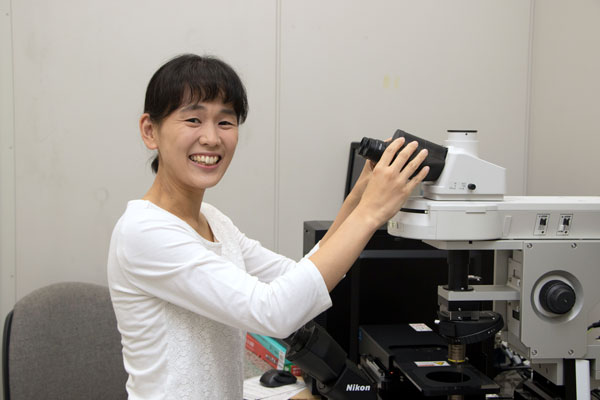Sep. 18, 2020
What really drives animal behavior?
Asuka Takeishi, RIKEN Hakubi Team Leader

Neural Circuit of Multisensory Integration, RIKEN Hakubi Research Team, RIKEN Cluster for Pioneering Research/RIKEN Center for Brain Science
Please describe your role at RIKEN.
I am the first Hakubi fellow to be part of the Kato-Sechi program and I lead a neuroscience lab studying animal behavior. As a recipient of a very competitive fellowship, I also feel I have a role in the promotion of gender diversity at RIKEN, especially as a working mom.
Describe your current research.
Animals are exposed to continuously changing environmental stimuli, such as temperature, odor, light and sound. We are interested in how animals integrate all this information within the brain and make behavioral decisions.
Many brain disorders are associated with behavioral problems, and we hope our research can contribute to understanding the fundamental mechanisms underlying these disorders.
What do you think has been the most interesting discovery in your field in the last few years?
Research in 2014 on fruit flies found that fruit fly sensitivity and taste preferences are controlled by 'feeding state'—fed or starved. It was an elegant series of experiments that showed that a regulatory mechanism of the nervous system was linked to a feedback mechanism based on the internal fed-state of the animal.
We tend to think of problems in complicated ways. However, I learned from this and other important studies that the fundamental mechanism of nature can be simple. This was a great example of a beautiful experiment.

My research is important for society because…
Knowledge obtained from studies using simple animals, such as nematode worm Caenorhabditis elegans, can reveal fundamental mechanisms that are universal. The mechanisms underlying behavioral decisions have been some of the biggest mysteries of neuroscience, although many neurological disorders are known to accompany behavior abnormalities. Ultimately, I hope our research can help us understand human behavior.
How did you become interested in your current field of research?
I’m interested in how an animal responds to stimuli. It's still a mystery how or why animals make certain decisions. I became interested in this because I wanted to work in natural conditions as much as possible, and found state/environment-dependent behavior dynamics research very attractive.
How has being at RIKEN helped your research?
Aside from the wonderful environment RIKEN provides, contact with the other talented personnel is most important to me. I am very lucky that I can interact and discuss science with high-level scientists. It was also very helpful that I could communicate and discuss my lab setup with skillful assistants, even before I joined. Thanks to the help of some RIKEN assistants, the promotion office, facilities section, other researchers at the RIKEN Center for Brain Science and the Hakubi budget, our rooms were renovated and supplied with all the reagents and machines needed to start experiments much sooner than I expected.
What are some technologies that you use for your research?
Sequencing services and fluorescent microscopes are a must for our research. It is incredibly helpful that we have the RIKEN BSI-Olympus Collaboration Center supplied with advanced confocal microscopes and advanced techniques for obtaining high-quality images.
What are your professional and personal goals?
My professional goal is to understand our brain mechanisms at a level that will help scientifically and reasonably explain or predict an individual’s behavior.
